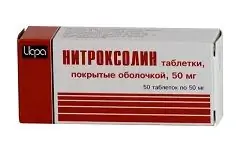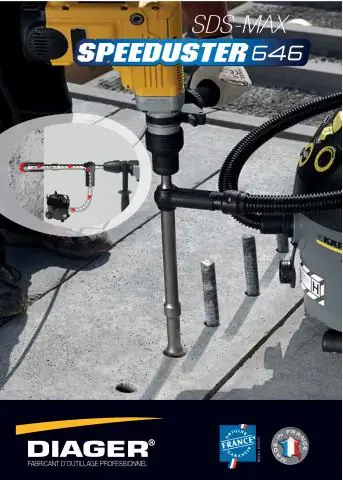- Author Rachel Wainwright [email protected].
- Public 2023-12-15 07:39.
- Last modified 2025-11-02 20:14.
Nitroxoline
Nitroxoline: instructions for use and reviews
- 1. Release form and composition
- 2. Pharmacological properties
- 3. Indications for use
- 4. Contraindications
- 5. Method of application and dosage
- 6. Side effects
- 7. Overdose
- 8. Special instructions
- 9. Use in childhood
- 10. Drug interactions
- 11. Analogs
- 12. Terms and conditions of storage
- 13. Terms of dispensing from pharmacies
- 14. Reviews
- 15. Price in pharmacies
Latin name: Nitroxoline
ATX code: J01XX07
Active ingredient: nitroxoline (nitroxoline)
Manufacturer: OJSC Tatkhimfarmpreparaty, OJSC Biosintez, OJSC Sintez, OJSC Avexima (Russia)
Description and photo update: 2019-14-08
Prices in pharmacies: from 66 rubles.
Buy

Nitroxoline is an antibacterial agent.
Release form and composition
The drug is available in film-coated tablets (50 pieces per package).
Active ingredient: nitroxoline, 1 tablet - 50 mg.
Pharmacological properties
Pharmacodynamics
Nitroxoline is an antimicrobial drug belonging to the oxyquinoline group. It is characterized by a wide spectrum of action.
Nitroxoline is a selective inhibitor of bacterial DNA (deoxyribonucleic acid) synthesis, has a bacteriostatic effect and forms complexes with metal-containing enzymes of microbial cells.
The drug is active against a number of gram-negative microorganisms (Enterobacter spp., Escherichia coli, Shigella spp., Proteus spp., Salmonella spp., Klebsiella spp.), Gram-positive microorganisms [Bacillus subtilis, Staphylococcus spp. (including Staphylococcus aureus), Corynebacterium diphtheriae, Streptococcus spp. (including Streptococcus pneumoniae, Enterococcus faecalis and beta-hemolytic streptococci)] and some other bacteria [Trichomonas vaginalis, Mycobacterium tuberculosis and some types of fungi (mold, dermatophytes, Candida spp. and some causative agents of deep mycoses)].
Nitroxoline is often quite effective in microflora resistance to other antibacterial drugs.
Pharmacokinetics
Nitroxoline is rapidly and almost completely absorbed from the gastrointestinal tract. It is excreted in the urine unchanged, and high concentrations of this substance are determined in it (100 μg / ml or more).
Indications for use
- Infectious and inflammatory diseases of the urinary tract caused by microorganisms sensitive to the drug (including cystitis, urethritis, pyelonephritis);
- Infected prostate adenoma and carcinoma;
- Epididymitis.
In addition, Nitroxoline tablets are used to prevent infectious complications when it is necessary to carry out medical or diagnostic interventions - cystoscopy, catheterization, surgery on the urinary tract and kidneys.
Contraindications
- Severe liver disease;
- Renal dysfunction with anuria, oliguria;
- Deficiency of glucose-6-phosphate dehydrogenase;
- Polyneuritis;
- Neuritis;
- Cataract;
- Pregnancy and lactation;
- Hypersensitivity to the drug or other 8-hydroxyquinoline derivatives.
According to the instructions, Nitroxoline should be used with caution in renal failure, because its cumulation is possible.
Instructions for the use of Nitroxoline: method and dosage
Nitroxoline tablets are taken orally during meals or immediately after meals.
Adults are prescribed 100 mg 4 times a day. In severe cases, a single dose is increased to 150-200 mg, the frequency of use is 4 times a day. The maximum allowable daily dose is 800 mg.
The duration of treatment depends on the type and severity of the disease. On average, the course of therapy is 2-3 weeks. If there is a need for repeated courses, 2-week breaks are taken between them.
Children over 5 years of age are prescribed 50-100 mg 4 times a day, children under 5 years of age - no more than 200 mg per day. The duration of treatment is 2-3 weeks. In chronic urinary tract infections, the drug is prescribed in courses of 2 weeks with a 2-week break.
For prophylactic purposes, after surgery on the urinary tract or kidneys, 100 mg is prescribed 4 times a day for 2-3 weeks.
Side effects
- Loss of appetite;
- Nausea, vomiting;
- Allergic reactions;
- Ataxia;
- Tachycardia;
- Headache;
- Liver dysfunction;
- Polyneuropathy;
- Paresthesia;
- Optic neuritis (with prolonged use).
Overdose
Possible accumulation of Nitroxoline in the body with its overdose may manifest itself with symptoms such as general weakness, nausea, vomiting, which usually disappear on their own after stopping treatment.
Overdose may be accompanied by an increase in dose-dependent adverse reactions. If any undesirable symptoms appear, it is recommended to temporarily stop taking the drug and immediately consult a doctor.
special instructions
During the treatment period, it is possible to stain urine in saffron-yellow color.
Influence on the ability to drive vehicles and complex mechanisms
When taking Nitroxoline, side effects from the central nervous system (dizziness, headache) may develop, therefore, during the course of treatment, it is recommended to be careful when driving vehicles and performing potentially hazardous work that requires increased concentration of attention and immediate psychomotor reactions.
Pediatric use
Prescribing the drug to children is possible according to the dosage regimen.
Drug interactions
- Medicines of the tetracycline group: summation of the effects of each drug;
- Nystatin, levorin: potentiation of action.
Nitroxoline should not be used simultaneously with nitrofurans, because when they interact, the summation of the negative neurotropic effect is noted.
Analogs
Nitroxoline analogues are: 5-Nitrox, 5-NOK, Nibiol, Nikinol, Nikopet, Niuron, Noxibiol, Noxin, Nitroxoline-UBF, Uritrol.
Terms and conditions of storage
Store away from light and moisture.
Shelf life is 4 years.
Terms of dispensing from pharmacies
Dispensed by prescription.
Reviews about Nitroxoline
As evidenced by reviews of Nitroxoline, many patients use it for cystitis, especially women. At the same time, they report a high effectiveness of treatment. However, there are opinions that the drug did not help quickly get rid of the unpleasant symptoms of the disease.
Some patients are interested in whether it is possible to take Nitroxoline during pregnancy. However, the use of this agent in pregnant women is contraindicated, therefore, if signs of the disease appear, it is better to consult a doctor.
Sometimes Nitroxoline is prescribed to children, but many parents, after studying the instructions for the medicine, seriously doubt whether it can be given at an early age. Doctors advise before starting treatment, be sure to pass tests and determine the sensitivity of pathogens to this antibiotic. This will determine the degree of effectiveness of such treatment. Until this time, taking Nitroxoline is not recommended.
If a drug is not suitable for a particular patient, alternative treatment options should be discussed with a specialist immediately. This guarantees a full recovery of health in the shortest possible time.
Price for Nitroxoline in pharmacies
The price of Nitroxoline in pharmacies is about 72‒125 rubles, depending on the manufacturer (the package contains 50 tablets).
Nitroxoline: prices in online pharmacies
|
Drug name Price Pharmacy |
|
Nitroxoline 50 mg film-coated tablets 50 pcs. RUB 66 Buy |
|
Nitroxoline 0.05 g film-coated tablets 50 pcs. RUB 68 Buy |
|
Nitroxoline 0.05 g film-coated tablets 50 pcs. RUB 70 Buy |
|
Nitroxoline pills 0.05g 50 pcs. 74 RUB Buy |
|
Nitroxoline tablets p.o. 50mg 50 pcs. Tatkhimpharmaceuticals 74 RUB Buy |
|
Nitroxoline 50 mg film-coated tablets 50 pcs. 124 RUB Buy |
|
Nitroxoline tablets p.o. 50mg 50 pcs. Anzhero-Sudzhensky KhFZ 153 r Buy |

Maria Kulkes Medical journalist About the author
Education: First Moscow State Medical University named after I. M. Sechenov, specialty "General Medicine".
Information about the drug is generalized, provided for informational purposes only and does not replace the official instructions. Self-medication is hazardous to health!






